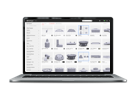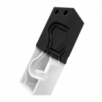
How do you stay competitive in a highly competitive industry like the oil and gas industry?
For over 30 years, Farason Corporation has designed and supplied custom automation and robotic systems to manufacturers, delivering over 900 systems to North America, Asia, South America, and Europe. Farason added Markforged 3D printers to expand its design and production capabilities, fulfilling its promise to customers to provide unique solutions tailored precisely to their individual challenges. Farason Corporation employees developed a mechanical gripper with a custom sleeve for a robotic automation solution in the packaging process.
The customer
Founded in 1933, Dixie Iron Works manufactures valves, fittings, process pumps, and other flow control equipment for the oil and gas industry. The company's mission is to provide the highest quality and safest flow regulators. Dixie Iron Works is also known by its main product line, MSI.
Over the past two decades, the tremendous growth in the oil and gas industry has attracted new competitors. As a result, Dixie's products became commoditized. Intense competition drove prices down to the point where rivals shifted production overseas to benefit from lower wages. With its two plants in Texas, Dixie continued to focus on manufacturing in the United States.
Current owner Gerard Danos is an engineer. He firmly believes that innovation secures Dixie Iron Works' future. He trusts his engineers and encourages them to develop creative solutions to the company's challenges. He has also diversified his workforce with young engineers already trained in additive manufacturing who bring new ideas to the table. This combination offers a unique opportunity to lead a manufacturing company.

The challenge
Danos recognized the need for innovation to remain relevant in the market, particularly through the development of new product designs that would justify premium prices. He was convinced that additive manufacturing could be a solution to enable faster design iterations and full-scale part production without disrupting the company's busy CNC production schedules.
So he invested in a Markforged X7, an industrial printer capable of producing continuous carbon fiber-reinforced composites. He also encouraged his engineers to explore the possibilities of printing with Onyx, a durable thermoplastic developed by Markforged, as well as printing metal parts.
"The greatest advantage of additive manufacturing is that it places no limits on creativity and the ability to quickly find solutions to customers' problems. Traditional manufacturing methods don't offer the ability to drive innovation as quickly."
– Gerard Danos, Managing Director, Dixie Iron Works

The solution
When a supplier wanted to bill Dixie a large sum for engineering modifications to a nylon O-ring carrier for 4.50 $, an opportunity arose to validate Danos' learning-by-doing approach. Dixie engineers improved the design of the support rings, manufactured them on their X7, and tested them. They were pleasantly surprised by the performance of the 3D-printed parts at the required operating pressures. This success inspired them to manufacture the parts themselves at a unit price of just 47 cents.
Dixie now produces 400 O-rings weekly using a fleet of ten Onyx One printers. This experience convinced Danos and his engineers to consider additive manufacturing a key role in the production of production parts.
As they expanded their knowledge of additive manufacturing, Dixie's engineers eventually reached the limits of the performance of 3D-printed composite parts. They wondered what could be done with metal and whether they could even create parts for production using this cutting-edge technology.
For Danos, investing in a Markforged Metal X printer was a simple decision. Offering the ability to produce industrial-grade metal parts, the Metal X was an ideal solution for Dixie Iron Works' growing production needs. It is more cost-effective than metal printers that rely on Laser Powder Bed Fusion (L-PBF). Additionally, the metal powder used is bonded by a polymer, eliminating the need for personal protective equipment to protect against the potentially hazardous loose powder.
Additionally, the Metal X uses the same Eiger software as the Onyx One and X7 printers used by Dixie, eliminating the need for engineers to learn new print management software. This compatibility made it easier to integrate the Metal X into existing processes.
Danos wasn't prepared for the next development. Production machine operators saw the quality of the 3D-printed metal parts and asked if they could use the printer to print metal parts in lower volumes for production—parts that would be complicated and time-consuming to set up on a CNC machine to produce a small number of parts.
become.

Eliminating the required tooling and setup time for these parts resulted in significant savings. The Dixie team realized they could cost-effectively produce parts for low-volume production on demand without straining the company's CNC production capabilities. Redesigning parts to fully leverage the benefits of additive manufacturing resulted in additional savings.
One part that Dixie Iron Works is manufacturing on the Metal X is a stop for a check valve. "Due to its unique flow properties, manufacturing it from solid stainless steel was very time-consuming and expensive," recalls Danos. "We also manufactured it using a casting process. However, to make this process profitable, we had to produce significantly higher quantities than we needed." The team now prints this part on demand on the Metal X.
Production costs are significantly lower, and Dixie Iron Works saves money on storing numerous parts that are rarely needed.
In another case, the team redesigned a small, complex part previously intended for CNC machining to better suit the Metal X process. An entire assembly was consolidated into a single component that uses 75 percent less material and can be manufactured with a single printer. In addition, carbon steel, which was prone to corrosion and performance issues, was replaced with 17-4 PH stainless steel. "We were able to reduce production costs (including labor) from 20 to 30 t/min to 5 t/min for the material," Danos emphasizes.
The Dixie Iron Works team also uses the Metal X to produce wear-resistant gripper tools for industrial automation. "In one case, we designed and printed long, thin grippers that had to be made of metal to achieve the required durability," he explained.
Despite the higher material costs of 3D-printed metal parts compared to similar CNC-machined parts, they become less expensive when you consider CNC machine programming, setup, tooling, and labor costs for skilled operators. For this reason, design for 3D printing has become one of the most important foundations of product development and continuous improvement at Dixie Iron Works.
“Metal 3D printing simplifies a very complex, labor-intensive, and costly process.”
– Gerard Danos, Managing Director, Dixie Iron Works

The future
The Metal X has dramatically expanded Dixie Iron Works' ability to design and produce metal parts and achieve the level of innovation Danos strives for. A key factor in the company's success is Danos' willingness to invest in additive manufacturing tools. His confidence in his team to maximize their potential also plays a significant role.
Danos is also exploring the capabilities of metal binder jetting printers such as Markforged's PX100. This technology would further enhance Dixie's capabilities in producing end-use components using additive manufacturing, enabling higher-volume production while maintaining the process efficiencies and cost savings achieved with the Metal X.










Hinterlasse einen Kommentar